Origin of Ice Cream
There is no text and literature which can exactly describe the origin of ice cream. According to ancient manuscripts a frozen product constituted by mixing of fruit juices with snow (today known as water ice) was consumed by chinese people. There is a century lag in literatures and after several years ice cream reappeared in different forms in Italy in the Middle Ages. From Italy, ice cream spread through Europe during the 17th century, and remained as a luxury product for the royal dinings. Towards the end of 19th century, industrial ice cream production was started when the first mechanical refrigerators were introduced.
Ice Cream and Related Products
Ice cream and related products can be categorized in various classes. As classification varies country to country, the following should be considered as a guideline only. Mainly it depends on the fat content of ice cream to categorise in a related class. More than 9% fat content is required in some countries to “qualify” for the ice cream category. Less than this level, the product is typically called milk ice, whereas ice cream with more than 12 to 13% fat is often categorized as either luxury or premium. The fat can be either of animal or vegetable origin.
Ice Cream Related Products
Sorbet is a frozen, typically fruit juice-based product having certain amount of overrun. The mix goes via a continuous freezer where air is introduced. Sorbet products characteristically have fresh eating properties and devoid of fat or milk solids-non-fat (MSNF). Owing to the higher viscosity from the freezers, fruit pieces and other inclusions can also be added to the sorbet product before filling. To achieve a final product wirh more body, ice cream manufacturers also produce sherbet that contains a small portion of fat and/or MSNF but retaining the fresh eating properties associated with sorbet. In 1980s, frozen yoghurt obtained a high popularity in the US owing to its relatively low fat and calorie content. Weight and cholesterol watchers were delighted.
Typically, a frozen yoghurt is a blend of standard ice cream mix and yoghurt with live bacteria, yoghurt ice cream have a fresher taste than standard ice cream. Nowadays, Greek yoghurt is popular owing to its high protein content. Water ice is a blend of sugar, fruit concentrates, stabilizers, flavour and colour. The finished mix is pasteurized and mainly filled into moulds (or pockets) on a rotary or in-line moulding machine. Freezing takes place in the pockets, which pass through a cold brine (salt solution) freezing zone. When the water ice is frozen , it is extracted from the pocket.
Water ice sticks are typical children’s products and great varieties in colour and flavour are quite common. Combinations together with an ice cream core also make the products appealing for adults. The development of extrusion technology has evolved a new category called as extruded water ice. Actually, a water ice containing a whipping agent is pumped to the continuous freezer, where air incorporation and a significant part of the freezing of water takes place in the continuous freezer cylinder before extrusion. The final product typically contains 20 to 30% air, is very fresh and has a clean flavour release.


Terminology Related to Ice Cream
Based on the filling methods, ice cream products categorised into the following categories:
- Filled
Ice cream is filled into cups, cones or containers/tubs, usually combined with many flavours and can be decorated with cream, chocolate, dry materials and ripple.
- Extruded
Ice cream is usually extruded onto a tray by using extrusion with a cutter. A vast variety of products may be produced including sandwiches, stick novelties, ball-top cones, desserts etc. Extrusion technology provides the possibility to work with ice cream drawn at much lower temperature where the viscosity of the ice cream is more due to more water being frozen into ice crystals. This generates ice creams that are both smoother due to smaller ice crystals and creamier due to higher churning of fat compared to moulding and filling technologies.
- Moulded
Ice cream or water ice mix is filled into moulds and frozen to form stick novelties. After extraction, the products are being dipped in chocolate or other coatings.
Ice Cream Processing

Also, read | New Age Technologies: A Boom to the Dairy Industry
Authors:

Vishal Yadav1* and Shivali Khandelwal2
1M.V.Sc. Scholar, Department of Veterinary Gynaecology and Obstetrics
2M.V.Sc. Scholar, Department of Veterinary Microbiology and Biotechnology
College of Veterinary and Animal Science, Bikaner
Rajasthan University of Veterinary and Animal Sciences, Bikaner (RAJUVAS – Bikaner), Rajasthan – 334001, India
*Corresponding author: Vishal Yadav (M.V.Sc. Scholar), email: vishalyadav1131997@gmail.com















